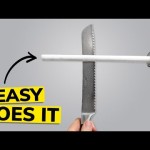
f3c50761c31f2389b55820577211e242
Having a sharp knife is essential for any kitchen. Whether you’re a professional chef or a home cook, having a sharp knife can make all the difference in the quality of your food. But how do you make sure your knife is sharp? In this guide, we’ll discuss the best way to sharpen a knife and the tools you’ll need to do it. We’ll also provide tips on how to maintain your knife’s sharpness and how to tell when it’s time to sharpen it. With this guide, you’ll be able to keep your knives sharp and ready for any culinary task.
How do you sharpen a knife with a guide
Sharpening a knife is an important part of knife maintenance. It is important to keep your knives sharp to ensure they are safe and effective to use. A guide is a great tool to help you sharpen your knives quickly and easily. Here is a step-by-step guide on how to sharpen a knife with a guide.
Step 1: Gather the Necessary Tools
Before you begin sharpening your knife, you will need to gather the necessary tools. You will need a sharpening guide, a sharpening stone, and a honing steel. You may also want to have a cloth or towel handy to wipe off the blade after sharpening.
Step 2: Secure the Knife in the Guide
Once you have all the necessary tools, you will need to secure the knife in the guide. Place the blade of the knife in the guide and make sure it is secure. The guide should be adjusted so that the blade is at the correct angle for sharpening.
Step 3: Sharpen the Knife
Once the knife is secure in the guide, you can begin sharpening the knife. Start by running the blade along the sharpening stone. Make sure to keep the blade at the same angle as the guide. Move the blade back and forth along the stone until it is sharp.
Step 4: Hone the Knife
Once the blade is sharp, you will need to hone it. To do this, run the blade along the honing steel. This will help to remove any burrs or imperfections on the blade. Make sure to keep the blade at the same angle as the guide.
Step 5: Clean the Knife
Once you have finished sharpening and honing the knife, you will need to clean it. Use a cloth or towel to wipe off any excess oil or debris from the blade. This will help to keep the blade clean and prevent it from rusting.
Conclusion
Sharpening a knife with a guide is a quick and easy way to keep your knives sharp. By following these steps, you can ensure that your knives are sharp and safe to use. With a little practice, you can become an expert at sharpening knives with a guide.
Does it matter which direction you sharpen a knife
Sharpening a knife is an important part of keeping it in good condition. But does it matter which direction you sharpen it in? The answer is yes, it does matter.
The direction you sharpen a knife in depends on the type of knife you have. For example, a straight-edged knife should be sharpened in one direction only, while a serrated knife should be sharpened in both directions.
When sharpening a straight-edged knife, it is important to use a sharpening stone or steel in the same direction as the blade. This will ensure that the blade is sharpened evenly and that the edge is not damaged. If you sharpen the blade in the opposite direction, it can cause the blade to become dull and uneven.
When sharpening a serrated knife, it is important to use a sharpening stone or steel in both directions. This will ensure that the blade is sharpened evenly and that the serrations are not damaged. If you sharpen the blade in one direction only, it can cause the blade to become dull and uneven.
It is also important to use the correct sharpening angle when sharpening a knife.
The angle should be between 15 and 20 degrees for a straight-edged knife and between 10 and 15 degrees for a serrated knife.
In conclusion, it does matter which direction you sharpen a knife. For a straight-edged knife, it should be sharpened in one direction only, while a serrated knife should be sharpened in both directions. It is also important to use the correct sharpening angle to ensure that the blade is sharpened evenly and that the edge or serrations are not damaged.
Do you push or pull when sharpening a knife
Sharpening a knife is an important part of knife maintenance. It is important to know the correct technique to sharpen a knife in order to get the best results. The question of whether to push or pull when sharpening a knife is one that is often asked.
The answer to this question depends on the type of sharpening tool being used. If you are using a sharpening stone, then you should always pull the knife towards you. This will ensure that the blade is evenly sharpened and that the angle of the blade is maintained. If you push the knife away from you, then you risk damaging the blade and not getting a good result.
If you are using a sharpening steel, then the technique is slightly different. With a sharpening steel, you should always push the knife away from you. This will help to ensure that the blade is evenly sharpened and that the angle of the blade is maintained. If you pull the knife towards you, then you risk damaging the blade and not getting a good result.
It is important to remember that whichever technique you use, you should always use a light touch. Applying too much pressure can damage the blade and make it difficult to get a good result. It is also important to use a consistent angle when sharpening the blade. This will help to ensure that the blade is evenly sharpened and that the angle of the blade is maintained.
In conclusion, the answer to the question of whether to push or pull when sharpening a knife depends on the type of sharpening tool being used. If you are using a sharpening stone, then you should always pull the knife towards you. If you are using a sharpening steel, then you should always push the knife away from you. It is important to use a light touch and a consistent angle when sharpening the blade in order to get the best results.
What are the 3 methods of sharpening knives
Knives are essential tools in the kitchen, and keeping them sharp is important for safety and efficiency. There are three main methods of sharpening knives: honing, sharpening, and stropping.
Honing
Honing is the process of realigning the microscopic teeth of the blade. This is done with a honing steel, which is a rod made of steel or ceramic. The honing steel should be held at a 20-degree angle to the blade and drawn along the length of the blade in a sweeping motion. This should be done on both sides of the blade.
Sharpening
Sharpening is the process of removing metal from the blade to create a new edge. This is done with a sharpening stone, which is a flat stone made of diamond, ceramic, or water. The stone should be held at a 20-degree angle to the blade and drawn along the length of the blade in a sweeping motion. This should be done on both sides of the blade.
Stropping
Stropping is the process of polishing the blade to a razor-sharp edge. This is done with a leather strop, which is a strip of leather with a compound on one side. The strop should be held at a 20-degree angle to the blade and drawn along the length of the blade in a sweeping motion. This should be done on both sides of the blade.
By honing, sharpening, and stropping your knives regularly, you can keep them in top condition and ensure that they are safe and efficient to use.
We hope this guide has been helpful in teaching you the right way to sharpen a knife. With the right tools and techniques, you can keep your knives sharp and in good condition for years to come. Thank you for reading and goodbye!







![Ceramic Knife Sharpener | 12" Overall ~Made in USA~ Wood Handle Honing Rod [NEW]](https://i.ebayimg.com/images/g/i0wAAOSwneRev6MA/s-l1600.jpg)







